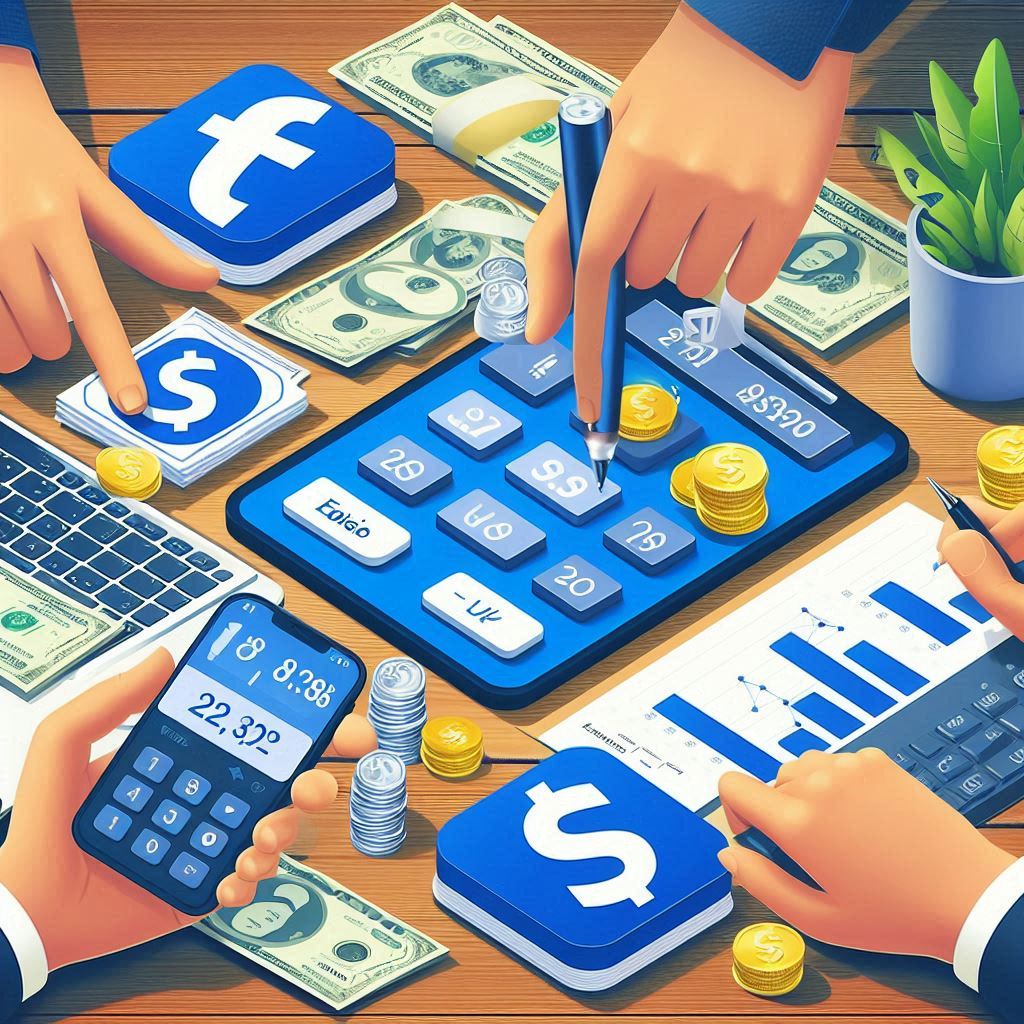In today’s digital age, Facebook Ads have become a key component of many marketing strategies. With its large user base and advanced targeting options, it offers businesses an unparalleled opportunity to reach their target audience. However, understanding the world of Facebook ads can be difficult, especially when it comes to understanding costs and optimizing spending.
What is Facebook Ads Cost and How to spend less?
If you’re planning to launch an ad on Facebook, you may wonder how much Facebook Ads cost and how to spend less. Facebook ads help you reach your target audience. However, it comes with a price. So, you need to make the right decision to not waste your money.
First, you need to learn about how Facebook ad cost works and what factors affect it. Then, you can launch your campaigns effectively. We will explain them in the following sections of this blog.
How Does Facebook Ad Pricing Work?
Facebook uses an ad auction system, which takes place when advertisers place a bid for a specific target audience. As a result of this auction, your Facebook ad cost will be determined. It ensures that your ad is displayed to the most relevant users at the most affordable price.
When you bid, it shows how much you’re willing to pay to reach your target audience. Also, Facebook checks the relevance of your ad to your target audience. If Facebook finds your ad relevant to your target audience, it displays your ad. Also, Facebook checks the estimated action rates. This is the possibility that someone will take action on your ad.

How Much Does Facebook Advertising Cost?
Facebook ad cost differs depending on several factors. While there’s no standardized answer, we can talk about average costs for Facebook Ads.
Facebook ads average Cost per Click: $0.69
Facebook ads average Cost per Mile: $9.88
Average Cost per Click (CPC)
It is the price you pay every time someone clicks on your ad. CPC is perfect for driving traffic to your website or landing page and is generally considered the most measurable metric for direct action. The average CPC for Facebook Ads is around $0.69.
Average Cost Per Mille (CPM)
This metric focuses on impressions rather than clicks. CPM, known as cost per mille, is the cost of being seen by 1,000 Facebook users. It’s an effective way to increase brand awareness and get your product or service seen by a wider audience. The average CPM for Facebook Ads is around $9.88.
Average Cost Per Lead (CPL)
It is known as cost-per-lead and focuses on the cost of acquiring a new lead. If someone shows interest in your product or service by signing up for a newsletter or downloading an offer, you pay the cost. CPL can be difficult to calculate on Facebook Ads, but tools and integrations can help you estimate it.
8 Factors Affecting Facebook Ads Cost
The cost of your campaigns can be affected by various factors. Each factor plays an important role in your ad cost. If you understand these factors, you can plan your strategy and optimize your ad cost successfully. Let’s look at the 8 factors that can have a big impact on your Facebook ad cost:
- Audience Targeting
Audience targeting is affecting your ad costs. When you’re launching your ads, you create a target audience according to demographics, interests, behaviors, etc. Your potential cost increases if your target audience is specific. Because your ads are shown to users who are more likely to be interested in your offers, narrowly defined audiences often have higher engagement rates and lower costs.
- Ad Quality and Relevance
Relevance and quality are essential for Facebook/Meta ads. Meta gives an ad relevance score to your ads. You can check whether your ads are relevant to the audience by using Facebook’s ad relevance diagnostics tool. A high relevance score makes your ads more likely to be shown. With that, you can achieve successful ads and pay lower costs.
- Ad Placement
There are a lot of placements like Facebook, Instagram, Messenger, and the Audience Network on Facebook and it affects ad costs. Each placement has different costs according to user engagement. You can select the most effective placements for your ads by trying different ones. Then, you can find the most cost-effective one for you.
- Seasonality and Trends
Facebook ads cost can change according to the seasonal trends. Customers may tend to spend more during peak seasons, and it affects the competition. So, your Facebook ad costs may increase. On the other hand, your cost can be lower during off-peak seasons. You can optimize your ad costs by being aware of these seasons.
- Bidding Strategy
Your ad bid also affects your Facebook ads costs. Facebook has three bidding strategies which are spend-based, goal-based, and manual bidding. Goal-based and spend-based bidding are Automatic bidding systems.
Usually, manual bidding may cause you higher ad costs, while automatic bidding may cause cost-effective results. You should find which one works best for you, and optimize your ad costs.
- Ad Objective
You need to choose a campaign objective while you’re creating a Facebook ad. It influences your ad cost directly. Each ad objective affects the cost differently. For example, if your ad objective is a purchase, it costs more than the impression objective. You need to choose an objective aligned with your goals and make your ads cost-effective.
- Competition
Facebook ads costs differ depending on your industry. Some industries can be more competitive. If the competition is high in your industry, bid prices and costs get higher. For example, in industries like finance, B2B, customer service, and insurance, competition can be higher, and it causes higher CPC.
- Location
The location also influences the amount you pay for your Facebook ads. If you launch an ad in a region with higher demand, you need to pay higher costs. You should choose specific locations with the potential to reach your audience effectively.
7 Tips to Reduce Your Facebook Ad Cost
Are you spending too much money on your ads? You don’t need to waste your money on ads that aren’t performing well. You can get cost-effective results by using Facebook ads efficiently. Let’s look at the effective strategies to reduce the wasted Facebook ads cost:
- Choose the Right Campaign Objective
Choosing the right campaign objective is important for cost-effective Facebook ads. It guarantees alignment with your marketing goals and optimizes ad delivery to target users most likely to take action, reducing costs per conversion.
Clear metrics help track performance while selecting the wrong objective can lead to wasted spend.
- Optimize Audience Targeting
If you are targeting a wide audience, you may have to compete with a large number of advertisers. This situation increases your ad spend.
You should find the audience that is most suitable for you and target this audience directly with your ads. Thus, your ads will be successful by reaching people who are likely to be interested in your products and you achieve higher conversion rates.
- Use Retargeting Campaigns
Retargeting campaigns are effective for reaching people who have previously interacted with the products or services you offer. These users are more likely to take actions such as purchasing, filling out a form, or liking. With these campaigns, you will get more effective results and avoid unnecessary costs.
- Lower Ad Frequency Score
When users see your ads in the same way over and over again, they lose interest over time. This is also called ad fatigue. This reduces the rate at which users engage with your ads. Then, you get a high ad frequency score and need to lower it.
If you renew your ads and reduce your ad frequency, you prevent users from getting bored with your ads and get better conversion rates. Regularly renewing your ads helps you.
- Make Your Campaigns Relevant
Publishing ads that are not relevant to your target audience will reduce your click-through rates and cause wasted expenses. If you create your ads by understanding your audience well, you will get high conversion rates and spend wisely.
- Improve the Post-Click Experience
Post-click experience is also important for your ads. If people click on the ad and are directed to an incorrect or slow-loading page, the user experience will suffer. Therefore, your customer satisfaction and conversion rates decrease. Again, you’ll be wasting your money by running an ad that doesn’t get results.
To prevent this, you must create a properly functioning marketing funnel and ensure the satisfaction of your customers.
- A/B Test with Different Ad Creatives and Placement
A/B testing provides great benefits to improve your ads. When creating your ads, you may not know which image or text will influence your target audience and take the action you want.
If you try different creatives and placements for your ads, you can understand which one brings better results. By changing your ads according to this data, you can create more effective ads and spend your money on the right ad.




